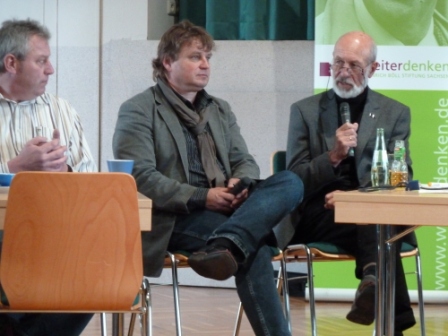Good practice from Saxony – Excursion to the commune Zschadrass
The commune of Zschdrass is a small community nowadays belonging to the municipality of Colditz in Saxony. Zschadrass is one of the most active communes when it comes to renewable energies and energy saving in Saxony. They are also very innovative in developing new concepts for communal energy production.
 According to the Mayor Matthias Schmiedel the commune started looking into their potential of saving energy in order to reduce their operation costs. The local council decided to start with the most visible and the easiest: in this case the street lightening. After 12 pm street lights have to be turned off.
According to the Mayor Matthias Schmiedel the commune started looking into their potential of saving energy in order to reduce their operation costs. The local council decided to start with the most visible and the easiest: in this case the street lightening. After 12 pm street lights have to be turned off.
After this they continued to observe the energy saving potential for communal building such as the gym and the school. Additionally, the commune was also looking for possibilities to keep the value added in the region which let also the vision of an energy self-sufficient commune in 2050.
The council decided to base the heating of communal buildings on local biomass. The small heating is running with wood chips that are based on local biomass.
 Wood is collected in the territory of Zschadrass when cutting trees and bushes on streets and parks. Citizens themselves are also bringing their wood from the gardens to the so called ‘Biomassehof’. This provides two third of biomass needed. The rest is produced in short rotation forestry by local farmers. They harvest in this way 10 to 12 t of wood each year.
Wood is collected in the territory of Zschadrass when cutting trees and bushes on streets and parks. Citizens themselves are also bringing their wood from the gardens to the so called ‘Biomassehof’. This provides two third of biomass needed. The rest is produced in short rotation forestry by local farmers. They harvest in this way 10 to 12 t of wood each year.
The wood chips need to be dehumidified. Together with an engineering office the commune developed a system to allow self drying of the wood chips. That takes 6-8 weeks. The wood pallets are then used all year in the small heating in the basement of the school.

Some years ago a new big wind engine of around 2 MW power has been installed. This tower is around 38 m high. The commune owns 20% of this wind engine and can provide free of charge kindergarten with the income of the sold energy.
After seeing all this places we got the possibility to discuss further with the mayor, experts from other municipalities, the ministry and the energy agency. In the discussion it became clear that it is essential to spread these good practices and encourage also other small communes to take steps towards energy savings and renewable energies. In leading by example the communes also encourage their citizens to consider changes in their energy use and production.
A big potential was underlined for citizen-action associations to produce energy. Furthermore, it was outlined several times that it is essential to involve citizens from the very beginning into any process in the commune that concerns e.g. new forms of energy production. The advantages for the commune have to be emphasised.

If well informed and involved the citizens are very willing to support council decision on changing energy production in the region and certainly also changing their own behaviour to become more energy efficient.





